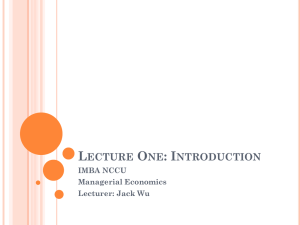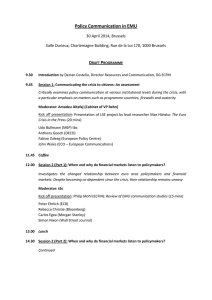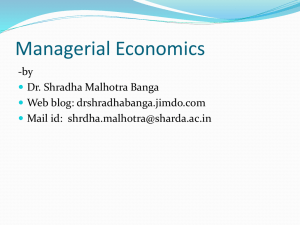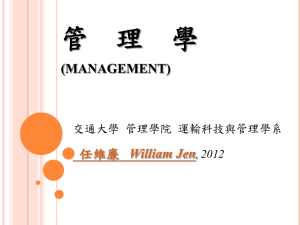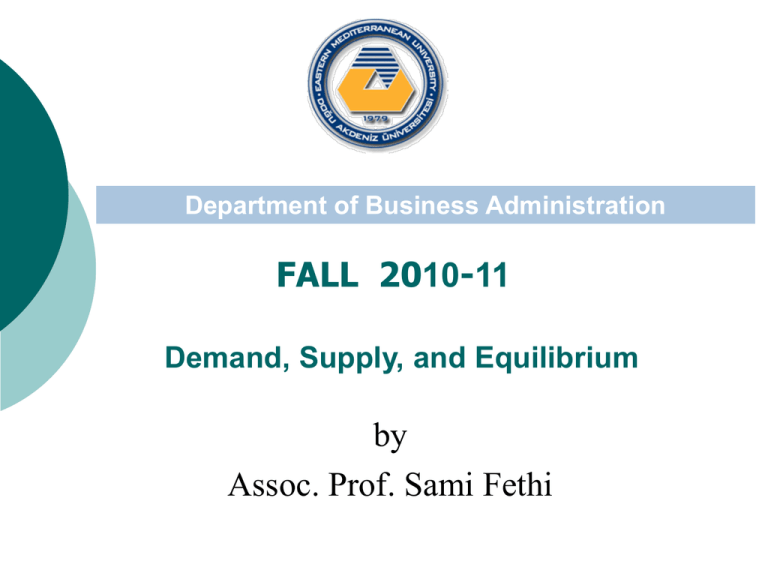
Department of Business Administration
FALL 2010-11
Demand, Supply, and Equilibrium
by
Assoc. Prof. Sami Fethi
Ch 3: Demand Theory
Demand and Supply
Economics begins and ends with
the “Law” of supply and demand.
The laws of supply and demand
are an important beginning in the
attempt to answer vital questions
about the working of a market
system.
2
© 2004, Managerial Economics, Dominick Salvatore
© 2010/11, Sami Fethi, EMU, All Right Reserved.
Ch 3: Demand Theory
Demand
Demand for a good or service is
defined as quantities of a good or
service that people are ready
(willing and able) to buy at various
prices within some given time
period, other factors besides price
held constant.
3
© 2004, Managerial Economics, Dominick Salvatore
© 2010/11, Sami Fethi, EMU, All Right Reserved.
Ch 3: Demand Theory
Supply
The supply of a good or service is
defined as quantities of a good or
service that people are ready to sell at
various prices within some given time
period, other factors besides price
held constant.
4
© 2004, Managerial Economics, Dominick Salvatore
© 2010/11, Sami Fethi, EMU, All Right Reserved.
Ch 3: Demand Theory
Demand Side
Every market has a demand side and a
supply side.
The demand side can be represented by a
market demand curve which shows the
amount of commodity buyers would like to
purchase at different prices.
Demand
curves
are
drawn
on
the
assumption that buyers’ tastes, income, the
number of consumers in the market and the
price of related commodities are unchanged.
5
© 2004, Managerial Economics, Dominick Salvatore
© 2010/11, Sami Fethi, EMU, All Right Reserved.
Ch 3: Demand Theory
Law of Demand
The inverse relationship between the price of
the commodity and the quantity demanded
per period is referred to as the law of
demand.
A decrease in the price of a good, all other
things held constant (ceteris paribus), will
cause an increase in the quantity demanded
of the good.
An increase in the price of a good, all other
things held constant, will cause a decrease in
the quantity demanded of the good.
6
© 2004, Managerial Economics, Dominick Salvatore
© 2010/11, Sami Fethi, EMU, All Right Reserved.
Ch 3: Demand Theory
Change in Quantity Demanded
Price
An increase in price
causes a decrease in
quantity demanded.
P1
P0
Q1
Q0
Quantity
7
© 2004, Managerial Economics, Dominick Salvatore
© 2010/11, Sami Fethi, EMU, All Right Reserved.
Ch 3: Demand Theory
Change in Quantity Demanded
Price
A decrease in price
causes an increase in
quantity demanded.
P0
P1
Q0
Q1
Quantity
8
© 2004, Managerial Economics, Dominick Salvatore
© 2010/11, Sami Fethi, EMU, All Right Reserved.
Ch 3: Demand Theory
Changes in Demand
Changes in price result in changes
in the quantity demanded.
This is shown as movement along the
demand curve.
Changes in nonprice determinants
result in changes in demand.
This is shown as a shift in the demand
curve.
9
© 2004, Managerial Economics, Dominick Salvatore
© 2010/11, Sami Fethi, EMU, All Right Reserved.
Ch 3: Demand Theory
Changes in Demand
Nonprice determinants of demand
Tastes and preferences
Income
Prices of related products
Future expectations
Number of buyers
10
© 2004, Managerial Economics, Dominick Salvatore
© 2010/11, Sami Fethi, EMU, All Right Reserved.
Ch 3: Demand Theory
Changes in Demand
Change in Buyers’ Tastes
-Today’ consumer purchases leaner meats compared to old
generations
-due to the level of blood cholesterol and body weight
Change in Buyers’ Incomes
Normal Goods
i.e., shoes, steaks, travel, automobiles, education
Inferior Goods
i.e., potatoes, hotdogs, hamburger
Change in the Number of Buyers
Change in the Price of Related Goods
Substitute Goods
i.e., Carrots can be replaced by cabbage
Complementary Goods
i.e., cars and gasoline or electric stove and electricity.
11
© 2004, Managerial Economics, Dominick Salvatore
© 2010/11, Sami Fethi, EMU, All Right Reserved.
Ch 3: Demand Theory
Change in Demand
An increase in demand
refers to a rightward shift
in the market demand
curve.
Price
P0
Q0
Q1
Quantity
12
© 2004, Managerial Economics, Dominick Salvatore
© 2010/11, Sami Fethi, EMU, All Right Reserved.
Ch 3: Demand Theory
Change in Demand
A decrease in demand
refers to a leftward shift
in the market demand
curve.
Price
P0
Q1
Q0
Quantity
13
© 2004, Managerial Economics, Dominick Salvatore
© 2010/11, Sami Fethi, EMU, All Right Reserved.
Ch 3: Demand Theory
Demand, Supply and Equilibrium
Every market has a demand side and a
supply side. The Supply side can be
represented by a market supply curve
which shows the amount of commodity
sellers would offer a sale at various
prices.
Supply curves are drawn on the
assumption of technology and input or
resources (as such labor, capital and
land) and prices.
14
© 2004, Managerial Economics, Dominick Salvatore
© 2010/11, Sami Fethi, EMU, All Right Reserved.
Ch 3: Demand Theory
Law of Supply
The direct relationship between the price of
the commodity and the quantity supplied per
period is referred to as the law of supply.
A decrease in the price of a good, all other
things held constant (ceteris paribus), will
cause a decrease in the quantity supplied of
the good.
An increase in the price of a good, all other
things held constant, will cause an increase
in the quantity supplied of the good.
15
© 2004, Managerial Economics, Dominick Salvatore
© 2010/11, Sami Fethi, EMU, All Right Reserved.
Ch 3: Demand Theory
Change in Quantity Supplied
A decrease in price
causes a decrease in
quantity supplied.
Price
P0
P1
Q1
Q0
Quantity
16
© 2004, Managerial Economics, Dominick Salvatore
© 2010/11, Sami Fethi, EMU, All Right Reserved.
Ch 3: Demand Theory
Change in Quantity Supplied
An increase in price
causes an increase in
quantity supplied.
Price
P1
P0
Q0
Q1
Quantity
17
© 2004, Managerial Economics, Dominick Salvatore
© 2010/11, Sami Fethi, EMU, All Right Reserved.
Ch 3: Demand Theory
Changes in Supply
Nonprice determinants of supply
Costs and technology
Prices of other goods or services
offered by the seller
Future expectations
Number of sellers
Weather conditions
18
© 2004, Managerial Economics, Dominick Salvatore
© 2010/11, Sami Fethi, EMU, All Right Reserved.
Ch 3: Demand Theory
Changes in Supply
Change in Production Technology
- An improvement in the technology and a reduction in
input prices would make it possible to produce a
commodity at a lower cost. This indicates that sellers
would be willing to sell more the goods at each price
Change in Input Prices
-↓ in agriculture product, ↓ price of lamb meat, ↑
quantity supplied so rightward shift in the market
supply curve
Change in the Number of Sellers
- ↑ in no of sellers, the market supply curve shifts to
right or ↓ in no of sellers, the market supply curve shifts
to left
Prices of other goods or services offered by the seller
- i.e., BMW, Mercedes, Woswagen (Subs. Goods)
- i.e., lamp meat and lamp leather (comp. Goods)
19
© 2004, Managerial Economics, Dominick Salvatore
© 2010/11, Sami Fethi, EMU, All Right Reserved.
Ch 3: Demand Theory
Change in Supply
An increase in supply
refers to a rightward shift
in the market supply curve.
Price
P0
Q0
Q1
Quantity
20
© 2004, Managerial Economics, Dominick Salvatore
© 2010/11, Sami Fethi, EMU, All Right Reserved.
Ch 3: Demand Theory
Change in Supply
A decrease in supply refers
to a leftward shift in the
market supply curve.
Price
P0
Q1
Q0
Quantity
21
© 2004, Managerial Economics, Dominick Salvatore
© 2010/11, Sami Fethi, EMU, All Right Reserved.
Ch 3: Demand Theory
Market Equilibrium
Market equilibrium is determined at the
intersection of the market demand curve and
the market supply curve.
Equilibrium price: The price that equates the
quantity demanded with the quantity supplied.
Equilibrium quantity: The amount that
people are willing to buy and sellers are willing
to offer at the equilibrium price level.
The
equilibrium
price
causes
quantity
demanded to be equal to quantity supplied.
An increase or decrease in the demand or
supply curve, it defines a new equilibrium point.
22
© 2004, Managerial Economics, Dominick Salvatore
© 2010/11, Sami Fethi, EMU, All Right Reserved.
Ch 3: Demand Theory
Market Equilibrium
Price
D
S
P
Q
Quantity
© 2004, Managerial Economics, Dominick Salvatore
If the quantity
supplied of a
commodity
exceeds the
quantity
demanded, this is
called excess
supply or surplus
between D and S
over point p.
If the quantity
demanded of a
commodity
exceeds the
quantity
supplied, this is
called excess
demand or
shortage
between D and S
below point p.
23
© 2010/11, Sami Fethi, EMU, All Right Reserved.
Ch 3: Demand Theory
Market Equilibrium
Shortage: A market situation in
which the quantity demanded exceeds
the quantity supplied.
A shortage occurs at a price below the
equilibrium level.
Surplus: A market situation in which
the quantity supplied exceeds the
quantity demanded.
A surplus occurs at a price above the
equilibrium level.
24
© 2004, Managerial Economics, Dominick Salvatore
© 2010/11, Sami Fethi, EMU, All Right Reserved.
Ch 3: Demand Theory
Market Equilibrium
25
© 2004, Managerial Economics, Dominick Salvatore
© 2010/11, Sami Fethi, EMU, All Right Reserved.
Ch 3: Demand Theory
Market Equilibrium
Price
D0
D1
S0
An increase in demand
will cause the market
equilibrium price and
quantity to increase.
P1
P0
Q0 Q1
Quantity
26
© 2004, Managerial Economics, Dominick Salvatore
© 2010/11, Sami Fethi, EMU, All Right Reserved.
Ch 3: Demand Theory
Market Equilibrium
Price
D1
D0
S0
A decrease in demand
will cause the market
equilibrium price and
quantity to decrease.
P0
P1
Q1 Q0
Quantity
27
© 2004, Managerial Economics, Dominick Salvatore
© 2010/11, Sami Fethi, EMU, All Right Reserved.
Ch 3: Demand Theory
Market Equilibrium
Price
D0
S0
P0
P1
Q0 Q1
S1
An increase
in supply
will cause
the market
equilibrium
price to
decrease and
quantity to
increase.
Quantity
28
© 2004, Managerial Economics, Dominick Salvatore
© 2010/11, Sami Fethi, EMU, All Right Reserved.
Ch 3: Demand Theory
Market Equilibrium
Price
D0
S1
P1
P0
Q1 Q0
S0
A decrease in
supply will
cause the
market
equilibrium
price to
increase and
quantity to
decrease.
Quantity
29
© 2004, Managerial Economics, Dominick Salvatore
© 2010/11, Sami Fethi, EMU, All Right Reserved.
Ch 3: Demand Theory
The Demand Schedule and the demand curve-Example
How can the relationship between quantity
demanded and price be portrayed?
Demand schedule
Demand curve
30
© 2004, Managerial Economics, Dominick Salvatore
© 2010/11, Sami Fethi, EMU, All Right Reserved.
Ch 3: Demand Theory
Table 1: A demand schedule for carrots
P (price per
ton)
D (quantity
demanded)
Thousands ton per
months
U
$ 20
110
V
40
90
W
60
77.5
X
80
67.5
Y
100
62.5
Z
120
60
Av income:$
Table
1
is
a
hypothetical demand
schedule for carrots.
It shows the quantity
of carrots that would
be demanded at
various prices on the
assumption
that
average household
income is fixed at $
20000 and all other
price do not change.
(i.e. if the price of
carrots were $60 per
ton,
consumers
would
desire
to
purchase
$77,500
tons of carrots per
month.
20000
31
© 2004, Managerial Economics, Dominick Salvatore
© 2010/11, Sami Fethi, EMU, All Right Reserved.
Ch 3: Demand Theory
A demand curve for carrots
A second method of showing the relation between
quantity demanded and price is to draw a graph. It is a
downward slope which indicates quantity demanded
increases as price falls.
140
120
Price
100
80
60
40
20
0
60
62.5
67.5
77.5
90
110
Quantity
32
© 2004, Managerial Economics, Dominick Salvatore
© 2010/11, Sami Fethi, EMU, All Right Reserved.
Ch 3: Demand Theory
Shifts in the demand curve-Example
A demand curve or line is drawn on the assumption that
everything except the commodity’s own price is held
constant. A change in any of variables previously held
constant will shift the demand curve or line to a new
position. (i.e. A rise in household income has shifted the
demand curve or line to the right.
A demand curve can shift in mainly two ways: If more
bought at each price, the demand curve shift right so that
each price corresponds to a higher quantity than before. If
less is bought at each price, the demand curve shifts left so
that each price represents to a lower quantity than before.
33
© 2004, Managerial Economics, Dominick Salvatore
© 2010/11, Sami Fethi, EMU, All Right Reserved.
Ch 3: Demand Theory
carrots
An
increase
Table 2: Two Alternative Demand Schedule for
P
Q (D)
Q1 (D1)
$ 20
110
140
40
90
116
60
77.5
100.8
80
67.5
87.5
100
62.5
81.3
120
60
78
Av in:
$ 20000
$ 24000
in
average income will
rise the quantity
demanded at each
price. When AV
income rises from
$20000 to $ 24000
per year, quantity
demanded at price of
$60 per ton increases
from 77500 tons per
month to 100800
tons per month.
Similar rise occurs at
every other price.
34
© 2004, Managerial Economics, Dominick Salvatore
© 2010/11, Sami Fethi, EMU, All Right Reserved.
Ch 3: Demand Theory
Table 2: Two Alternative Demand Schedule for carrots
Put differently, A rise in av household income shifts
the demand curve for most commodities to right so
this indicates that more will be demanded at each
possible price. Ultimately, the demand schedule
relating columns P and D is replaced by one relating
columns P and D1 in the previous table. The
graphical presentation of the two functions are seen
in the following graph.
35
© 2004, Managerial Economics, Dominick Salvatore
© 2010/11, Sami Fethi, EMU, All Right Reserved.
Ch 3: Demand Theory
Shifts in the demand curve-Example
Q (D)
Q1(D1)
$ 20
110
140
40
90
116
60
77.5
100.8
80
67.5
87.5
100
62.5
81.3
120
60
78
160
140
120
100
80
60
40
20
0
price
P
Q1D1
QD
60 80 90 100 120 140
Quantity
36
© 2004, Managerial Economics, Dominick Salvatore
© 2010/11, Sami Fethi, EMU, All Right Reserved.
Ch 3: Demand Theory
Other Prices
Earlier, we saw that the downward slope of a
commodity’s demand curve occurs because the lower
its price, the cheaper the commodity is relative to
other commodities that can satisfy the same needs or
desires. Those other commodities are called
substitutes (i.e. Carrots can be made cheap relative to
cabbage either by lowering the price of carrots or
raising the price of cabbage).
A rise in the price of a substitute for a commodity
shifts the demand curve for the commodity to the
right.
37
© 2004, Managerial Economics, Dominick Salvatore
© 2010/11, Sami Fethi, EMU, All Right Reserved.
Ch 3: Demand Theory
Other Prices
Another class of commodities is called complements.
These are the commodities that tend to be used
jointly each other. Such as cars and gasoline or
electric stove and electricity.
A fall in the price of a complementary commodity
will shift a commodity’s demand curve to the right.
For example, a fall in the price of airplane trips to
Paris will lead to a rise in the demand for Disney
Land tickets at paris even though their price is
unchanged.
38
© 2004, Managerial Economics, Dominick Salvatore
© 2010/11, Sami Fethi, EMU, All Right Reserved.
Ch 3: Demand Theory
Tastes
Tastes have a large effect on people’s
desired purchased. A change in tastes may
be long-lasting such as the shift from
fontain pens to ball-point pens. In this
case, a change in tastes in favor of a
commodity shifts the demand curve to the
right.
39
© 2004, Managerial Economics, Dominick Salvatore
© 2010/11, Sami Fethi, EMU, All Right Reserved.
Ch 3: Demand Theory
Distribution of Income
A change in the distribution of income will shift to
the right the demand curves for commodities
bought most by those gaining income. On the other
hand, it will shift to the left the demand curves for
commodities bought most by those losing income.
If, for example, the government increases the
deductions for children on the income tax and
compensates by raising basic taxes, income will be
transferred from childness persons to the large
familes. So commodity more heavily bought by
families with no child decline in demand.
40
© 2004, Managerial Economics, Dominick Salvatore
© 2010/11, Sami Fethi, EMU, All Right Reserved.
Ch 3: Demand Theory
Population
Population growth does not by itself create new
demand. The additional people must have
purchasing power before demand is changed.
Extra people of working age, however, usually
means extra output and if they produce, they will
earn income.
When this happens, the demand for all the
commodities purchased by the new income earners
will rise. Thus a rise in population will shift the
demand curves to the right.
41
© 2004, Managerial Economics, Dominick Salvatore
© 2010/11, Sami Fethi, EMU, All Right Reserved.
Ch 3: Demand Theory
Individual Demand function
The demand for a commodity arises from the
consumers’ willingness and ability to purchase the
commodity. Consumer demand theory postulates
that the quantity demanded of a commodity is a
function of / or depends on the price of the
commodity, the consumers’ income, the price of
related commodities, and the tastes of the
consumer.
42
© 2004, Managerial Economics, Dominick Salvatore
© 2010/11, Sami Fethi, EMU, All Right Reserved.
Ch 3: Demand Theory
Functional form
Qdx= (Px, I, Py, T)
An inverse relationship is expected between
the quantity demanded of a commodity and
its price (law of demand). That is, when the
price rises, the quantity purchased declines,
and when the price falls, the quantity sold
increases.
43
© 2004, Managerial Economics, Dominick Salvatore
© 2010/11, Sami Fethi, EMU, All Right Reserved.
Ch 3: Demand Theory
Functional form
Qdx= (Px, I, Py, N,T)
QdX/PX < 0
QdX/I > 0 if a good is normal
QdX/I < 0 if a good is inferior
QdX/PY > 0 if X and Y are substitutes
QdX/PY < 0 if X and Y are complements
44
© 2004, Managerial Economics, Dominick Salvatore
© 2010/11, Sami Fethi, EMU, All Right Reserved.
Ch 3: Demand Theory
Recall: Consumer Demand Theory
Consumer demand theory postulates that the quantity
demanded of a commodity per time period increases with a
reduction in its price, with an increase in the consumer’s
income, with an increase in the price of substitute
commodities and a reduction in the price of complementary
commodities, and with an increased taste for the commodity.
On the other hand, the quantity demanded of a commodity
declines with the opposite changes.
Consumer demand theory postulates that the quantity
demanded of a commodity is a function of / or depends on
the price of the commodity, the consumers’ income, the price
of related commodities, the number of consumers in the
market, and the tastes of the consumer.
45
© 2004, Managerial Economics, Dominick Salvatore
© 2010/11, Sami Fethi, EMU, All Right Reserved.
Ch 3: Demand Theory
Relating Concepts
The increase in Qx when Px falls occurs because in
consumption, the individual consumer substitutes commodity x
for other commodities which are now relatively expensive. This
is called the substitution effect.
In addition, when Px falls, a consumer can purchase more of x
with a given amount of money (i.e., the consumer’s real income
increases). This is called the income effect.
The movement along a given demand curve resulting from a
change in the commodity price is referred to as a change in the
quantity demanded, while a shift in the demand curve resulting
from a change in any of the factors that affect demand, other
than the commodity price, is referred to as a change in demand.
46
© 2004, Managerial Economics, Dominick Salvatore
© 2010/11, Sami Fethi, EMU, All Right Reserved.
Ch 3: Demand Theory
Individual and Market Demand Curve Example
Horizontal Summation: From Individual to Market Demand
47
© 2004, Managerial Economics, Dominick Salvatore
© 2010/11, Sami Fethi, EMU, All Right Reserved.
Ch 3: Demand Theory
Individual and Market Demand Curve Example
Given the following data: Pdx=$4 and Qdx=4 and
Qddx=400, while at Px=$3, Qdx=6 and Qdd=600,
construct the relevant individuals and market curves
Market
8
6
4
2
0
Px
Px
Individuals
0
2
4
6
8
10
Qdx
12
8
6
4
2
0
0
200
400
600
800
1000
1200
Qdx
48
© 2004, Managerial Economics, Dominick Salvatore
© 2010/11, Sami Fethi, EMU, All Right Reserved.
Ch 3: Demand Theory
Price Elasticity of Demand
The price elasticity of demand (Ep) is
measured by the percentage change
in the quantity demanded of the
commodity divided by the percentage
change in commodity’s price, holding
constant all other variables in the
demand function.
Q / Q Q P
EP
P / P P Q
49
© 2004, Managerial Economics, Dominick Salvatore
© 2010/11, Sami Fethi, EMU, All Right Reserved.
Ch 3: Demand Theory
Price Elasticity of Demand
Point Definition
Or Elasticity at
given point
Q / Q Q P
EP
P / P P Q
Linear Function
P
EP a1
Q
50
© 2004, Managerial Economics, Dominick Salvatore
© 2010/11, Sami Fethi, EMU, All Right Reserved.
Ch 3: Demand Theory
Price Elasticity of Demand
Arc Definition
Q2 Q1 P2 P1
EP
P2 P1 Q2 Q1
51
© 2004, Managerial Economics, Dominick Salvatore
© 2010/11, Sami Fethi, EMU, All Right Reserved.
Ch 3: Demand Theory
Marginal Revenue and Price Elasticity of Demand
1
MR P 1
E
P
52
© 2004, Managerial Economics, Dominick Salvatore
© 2010/11, Sami Fethi, EMU, All Right Reserved.
Ch 3: Demand Theory
Price Elasticity of Demand- Example
Market
Px
8
A
6
4
2
0
0
B
200
C
400
D
600
E
800
Qdx
F
G
1000 1200
Find Ep at point A,
B, C and G
Ep=(ΔQ/ ΔP)
(P/Q)
At point A, Ep=(0200/ 6-5) (6/0)
Ep=-200 (6/0)= indefinite
At point B, Ep=
(200-400/5-4)
(5/200)=-5
At point C,
Ep=(400-600/4-3)
(4/400)=-2
At point G,
Ep=(-200)(0/1200)=0
53
© 2004, Managerial Economics, Dominick Salvatore
© 2010/11, Sami Fethi, EMU, All Right Reserved.
Ch 3: Demand Theory
Price Elasticity of Demand- Example
Find Ep at point A, B, C and G
Ep=(ΔQ/ ΔP) (P/Q)
At point A, Ep=(-200/ 6-5) (6/0)
Ep=-200 (6/0)= - indefinite
At point B, Ep= (200-400/5-4)
(5/200)=-5
At point C, Ep=(400-600/4-3)
(4/400)=-2
At point G, Ep=(-200) (0/1200)=0
54
© 2004, Managerial Economics, Dominick Salvatore
© 2010/11, Sami Fethi, EMU, All Right Reserved.
Ch 3: Demand Theory
Arc Elasticity of Demand- Example
Find arc Ep between points B and C
Ep=(Q2-Q1)/(P2-P1) (P2+P1)(Q2+Q1)
Ep= (400-200)/(4-5) (4+5)/(400+200)
Ep=-3
Market
Absolute value of Ep
8
A
Greater than 1- elastic
6
B
C
4
D
Equals 1- unit elastic
2
0
Less than 1- inelastic
Px
0
200
400
600
E
800
F
G
1000
1200
Qdx
55
© 2004, Managerial Economics, Dominick Salvatore
© 2010/11, Sami Fethi, EMU, All Right Reserved.
Ch 3: Demand Theory
MR and TR based on Elasticity- Example
P
Q
Ep
TR=P.Q
(1)
(2)
(3)
(4)
$6
0
-indefinite
$0
-
5
200
-5
1,000
5
4
400
-2
1,600
3
3
600
-1
1,800
1
2
800
-1/2
1,600
-1
1
1,000
-1/5
1,000
-3
0
1,200
0
0
-5
MR=DTR/D
Q
(5)
56
© 2004, Managerial Economics, Dominick Salvatore
© 2010/11, Sami Fethi, EMU, All Right Reserved.
Ch 3: Demand Theory
MR and TR based on Elasticity- Example
Find MR by using P and Ep at Px =$4 and $3
MR= P{1+(1/Ep)}
At Px =$4 MR=4{1+(1/-2)=$2
At Px =$3 MR=3{1+(1/-1)=0
Based on the previous table:
P decreases TR increases when Ep is elastic
TR max or unchanged when Ep is unitary
elastic
TR decreases when Ep is inelastic
57
© 2004, Managerial Economics, Dominick Salvatore
© 2010/11, Sami Fethi, EMU, All Right Reserved.
Ch 3: Demand Theory
Graphically Showing Elasticities and MR-TR
MR>0 MR<0
EP 1 E 1
TR
P
0
600
EP 1 MR=0
© 2004, Managerial Economics, Dominick Salvatore
1200
QX
58
© 2010/11, Sami Fethi, EMU, All Right Reserved.
Ch 3: Demand Theory
Graphically Showing Elasticities and MR-TR
PX
6
EP 1
EP 1
EP 1
0
600
1200
QX
MR
X
© 2004, Managerial Economics, Dominick Salvatore
59
© 2010/11, Sami Fethi, EMU, All Right Reserved.
Ch 3: Demand Theory
Income Elasticity of Demand
Point Definition
Linear Function
EI
Q / Q Q I
I / I
I Q
EI a3
I
Q
60
© 2004, Managerial Economics, Dominick Salvatore
© 2010/11, Sami Fethi, EMU, All Right Reserved.
Ch 3: Demand Theory
Income Elasticity of Demand
Arc Definition
Normal Good
E
I
0
Luxuries Good
E
I
1
Q2 Q1 I 2 I1
EI
I 2 I1 Q2 Q1
Inferior Good
EI 0
Necessities Good
0 <I E < 1
61
© 2004, Managerial Economics, Dominick Salvatore
© 2010/11, Sami Fethi, EMU, All Right Reserved.
Ch 3: Demand Theory
Cross-Price Elasticity of Demand
Point Definition
Linear Function
QX / QX QX PY
EXY
PY / PY
PY QX
E XY a4
PY
QX
62
© 2004, Managerial Economics, Dominick Salvatore
© 2010/11, Sami Fethi, EMU, All Right Reserved.
Ch 3: Demand Theory
Cross-Price Elasticity of Demand
Arc Definition
QX 2 QX 1 PY 2 PY 1
EXY
PY 2 PY 1 QX 2 QX 1
Substitutes
Complements
EXY 0
EXY 0
63
© 2004, Managerial Economics, Dominick Salvatore
© 2010/11, Sami Fethi, EMU, All Right Reserved.
Ch 3: Demand Theory
Income, Cross and Arc Elasticises- Example
Find arc EI between two levels of income i.e I=$10000
and I=$ 11000 when the demand for commodity X is
400.
Market
Ep=(Q2-Q1)/(I2-I1) (I2+I1)(Q2+Q1)
8
A
6
B
C
D
Ep= (600-400)/(11-10) (11+10)/(600+400) 42
E
F
0
EI= 4.2
0
200 400 600 800 1000
Qdx
Thus commodity x is normal and luxury.
Find arc Exy between two levels of price y i.e Py=$ 1
and Py =$ 2 when the demand for commodity X is 400.
Ep=(Q2-Q1)/(P2-P1) (P2+P1)(Q2+Q1)
EXY 0
Ep= (600-400)/(2-1) (2+1)/(600+400)
Substitutes
EI= 0.6
Thus commodity y is substitute compared to
commodity X
Px
G
1200
64
© 2004, Managerial Economics, Dominick Salvatore
© 2010/11, Sami Fethi, EMU, All Right Reserved.
Ch 3: Demand Theory
Using Elasticises In Managerial Decision Making-Example
A firm selling coffee brand X and estimated
relevant demand regression as follows:
Qx=1.5-3.0 Px+0.8 I+2.0 Py-0.6 Ps+1.2 A
Qx is sales of coffee brand X, I is disposable
income, Py is price of competitive coffee brand,
Ps is price of sugar and A is advertising
expenditures for coffee brand X.
Suppose: Px=$2, I=$2.5, Py=$1.80, Ps=$0.50
and A=$1
65
© 2004, Managerial Economics, Dominick Salvatore
© 2010/11, Sami Fethi, EMU, All Right Reserved.
Ch 3: Demand Theory
Using Elasticities In Managerial Decision Making Example
Calculate Qx and the elasticities of sales with respect to
each variable in the relevant demand function
Qx=1.5-3.0(2)…1.2(1)=2 mn pounds coffee
Calculate the elasticities of the demand for coffee brand X
Ep=-3(2/2)=-3,Ei=0.8(2.5/2)=1, Exy=2(1.8/2)
Exs=-0.6(0.5/2)=-0.15, Ea=1.2(1/2)=0.6
RECALL the Formulae
EP
P
a1
Q
E XY a4
PY
QX
EI a3
I
Q
66
© 2004, Managerial Economics, Dominick Salvatore
© 2010/11, Sami Fethi, EMU, All Right Reserved.
Ch 3: Demand Theory
Using Elasticises In Managerial Decision Making-Example
Next year, the firm would like to increase Px
by 5%, A by 12%, I by 4%, and Py 7%
whereas Ps fall by 8%.
Determine sales of coffee brand X in the
next year.
Qxx=Qx+Qx(DPx/Px)Ep……+Qx(DA/A)Ea
Qxx=2+2(5%)(-3)…..+2(5%)(0.6)
Qxx=2.2 or 2,200,000 pounds
67
© 2004, Managerial Economics, Dominick Salvatore
© 2010/11, Sami Fethi, EMU, All Right Reserved.
Ch 3: Demand Theory
The important steps by using Elasticities
The analysis of the forces or variables that affect on
demand and reliable estimates of their quantitative effect
on sales (elasticities) are essential in order for firm to make
best operating decisions in shor-run and to plan for its
growth in the long-run.
The firms can use the elasticities of demand of the
variables under their controls to find out best policies as
well as to maximize their profits.
If the demand for the firm’s product is price inelastic, the
firm will want to increase the product price since that would
increase its total revenue and reduce its total cost.
If the elasticity of the firm’s sales wrt the variable beyod
its control or If the cross-price elasticity of demand for the
firm’s product is very high, the firm will need to respond
quickly to a competitor’s price reduction otherwise losing a
great deal of its sales.
68
© 2004, Managerial Economics, Dominick Salvatore
© 2010/11, Sami Fethi, EMU, All Right Reserved.
Ch 3: Demand Theory
The important steps by using Elasticities
The size of the price elasticity of demand is larger,
the closer and the greater is the number of available
substitutes for the commodity. For example, sugar is
more price elastic than table salt (e.g. honey)
In general, the greater is its price elasticity of
demand, the greater will be the number of
substitutes
For a given price change, the quantity response is
likely to be much larger in the long run than short
run so the price elasticity odf demand is likely to be
much greater in the long run than short run .
69
© 2004, Managerial Economics, Dominick Salvatore
© 2010/11, Sami Fethi, EMU, All Right Reserved.
Ch 3: Demand Theory
The End
Thanks
70
© 2004, Managerial Economics, Dominick Salvatore
© 2010/11, Sami Fethi, EMU, All Right Reserved.



